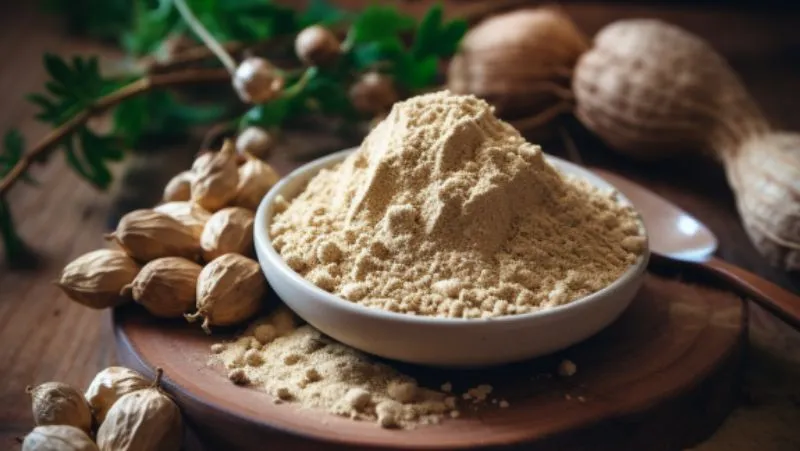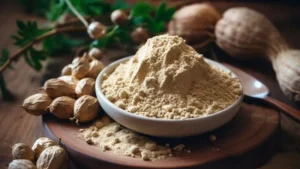Spoilers for this article
- Maca andashwagandha (type of Indian cactus)The combination of increased energy andstresssuch as the mitigation ofsynergyThis could result in a
- Bothsupplementhas a specificside effectand ... andinteractionCaution should be exercised for safe intake because the risk of
- supplementWhen selecting the "I", check the list of ingredients and,KSM-66and other wise wise decisions, such as choosing a reliable brand.
With Maca.ashwagandha (type of Indian cactus)And is it safe to take them together?"
"These twosupplementWhat effect does the combination of the two have?"
"Which brand of maca and which brand ofashwagandha (type of Indian cactus)I'd like to know what you recommend."
This article is for those who are interested in this topic.
Introduction.
In recent years, many people seeking to improve their health, beauty, and daily performanceSuperfoods and herbsis attracting a lot of attention.
In particular, theMaca (Macao)andashwagandha (type of Indian cactus)(Withania somnifera)has been recognized worldwide for its effectiveness, and many studies and testimonials exist.
This article provides basic information on these two superfoods and details their benefits.
Brief introduction to maca and ashwagandha (Withania somnifera)
- Maca (Macao)
- origin: Maca is native to the Andes Mountains of South America and has been used traditionally for thousands of years.
- Main effects: Increases energy, supports sexual function, and regulates hormonal balance.
- Shape and Use: Usually dried roots.powderThe product is used as asmoothieand ... andcookingand ingested by adding it to the
- ashwagandha (type of Indian cactus)(Withania somnifera)
- origin: ashwagandha (type of Indian cactus)is native to India and has long been used in Ayurveda (traditional Indian medicine).
- Main effects: stressReduction of theimmunityImprovement of thememoryinterpoint (interword separation)(powers of) concentrationsupport, etc.
- Shape and Use: Dried roots and leaves.fine powderin turncapsuleand ... andteeIt is commonly taken as
References:.
Basic Information on MACA
History and Origins
Maca,Andes MountainsThis plant is native to the high altitudes of thePeruIt is well known for its cultivation in the region.
Indigenous peoples in the region have used maca as a foodstuff and medicine for thousands of years.

Tradition has it that during the ancient Inca Empire, warriors ingested maca before battle to increase their strength and courage.
Main Effects and Benefits
Maca.Main Effects and Benefits
- energy booster: Maca is known as a natural source of energy and helps to refresh a tired body.
- Hormone balance adjustment: It is said to be especially helpful in alleviating menstrual irregularities and menopausal disorders in women.
- Support for sexual function: Maca is used to improve libido and malereproductive functionThe reported effect of supporting the
- antioxidant action: Prevents oxidation in the body, prevents aging andimmunityStudies suggest that it contributes to the enhancement of
- memoryinterpoint (interword separation)(powers of) concentrationImprovement of: by maca ingestion.brain functionsupport has been confirmed in some studies.
Side Effects and Precautions
Maca.Side Effects and Precautions
- digestive symptoms: Ingestion of large amounts may cause stomach upset and diarrhea.
- hormone overload: May affect hormonal balance in some people.
- overdose: Consumption in excess of recommended amounts should be avoided, and consultation with a physician is recommended for continued high intake.
- Pregnancy and lactation: Pregnant and lactating women should consult with a physician prior to ingestion.
References:.
Basic Information on Ashwagandha (Withania somnifera)
History and Origins
ashwagandha (type of Indian cactus)isIndiaIt is a plant native to South Asia, mainly in the southern part of the world, with a history that spans thousands of years.
This herb isAyurveda (traditional system of medicine practiced in India)(traditional Indian medicine) has played a very important role in

ashwagandha (type of Indian cactus)The name "M. nipponica" means "horse smell" in Sanskrit and is said to derive from its tonic effect and the unique aroma of the root.
Main Effects and Benefits
Ashwagandha'sMain Effects and Benefits
- stressreduction: ashwagandha (type of Indian cactus)has properties as an adaptogen, and the body'sstressIt has the effect of mitigating reactions.
- Improved immune function: It is believed to strengthen the immune system and increase resistance to disease.
- Memory.(powers of) concentrationSupport for: In some studies,brain functionand supports memory and(powers of) concentrationIt has been suggested that this may improve the
- antioxidant action: It is known to prevent cell oxidation and contribute to the prevention of aging and maintenance of health.
- anti-inflammatoryeffect: Studies have shown that it has the ability to reduce inflammation in the body.
Side Effects and Precautions
Ashwagandha'sSide Effects and Precautions
- Gastrointestinal disorders: In some individuals, gastrointestinal symptoms such as stomach pain and diarrhea may occur after ingestion.
- Consumption during pregnancy and lactation: Pregnant and lactating women shouldashwagandha (type of Indian cactus)It is recommended to avoid the intake of
- thyroid glandOveractivity of: thyroid glandBecause of the effect of augmenting the activity ofthyroid glandPeople with diseases related to the following conditions should consult a physician before ingestion.
- With other drugsinteraction: Since concomitant use with certain medications is not recommended, consultation with a physician is required if you are already taking pharmaceuticals.
References:.
What is an adaptogen?
Definition and function of adaptogens
Adaptogens are the organism'sstressand plants and herbs that support the ability to adapt to fatigue. Adaptogens are believed to have three main properties
Definition and function of adaptogens
- ... completelystressRegulate response: Adaptogens are the body'sstressIt is believed that the effect is to alleviate reactions to
- Low toxicity: Usually, adaptogens are harmful to the body.side effectIt can be used safely for a long period of time without causing
- Uniform effect on the entire body: Adaptogens are thought to support overall balance and harmony, not just in specific parts of the body.
Scientific Evidence for Adaptogens
Although scientific research on adaptogens is still in its early stages, there is evidence that
Scientific Evidence for Adaptogens
- stressHormone regulation: Adaptogens are,cortisoletc.stressIt has been suggested that it may regulate hormone levels.
- neuroprotective effect: Some adaptogens protect nerve cells,brain functionStudies have also reported that it is effective in supporting
- Strengthens immune function: Studies have shown that adaptogens may strengthen the immune system and support the body's natural defenses.
- antioxidant action: Some adaptogens reduce oxidation in the body.antioxidant actionIt is believed that there are
References:.
Benefits and possibilities when maca and ashwagandha are used together
Synergistic effects of increased energy and stress relief
Maca is known to contribute to increased energy and endurance.
On the other hand.ashwagandha (type of Indian cactus)because of its properties as an adaptogen,stressIt is believed to support the body's ability to adapt to stress and fatigue.

These are used together,As well as an increase in daily activities.stressAccelerated recovery fromThe following is a list of the possible
Supports immune system and hormonal balance
ashwagandha (type of Indian cactus)has been shown to strengthen immune function, and positive effects on the immune system have also been reported for maca.

In addition, both have the effect of balancing hormones, and therefore, the body'sStable internal environment andimmunityImprovement ofmay be supported.
Relief from fatigue and physical conditioning
Maca helps support recovery from fatigue,ashwagandha (type of Indian cactus)also help restore balance to the body as adaptogens.

By this,Faster recovery from persistent fatigue and physical discomfortPossibilities are considered.
Synergy: Expected effect of combining both
Maca andashwagandha (type of Indian cactus)The combined use of the two is a synergistic effect of the two,Increased energy levels,stressReduction of fatigue, recovery from fatigue, and stabilization of hormonal balanceand other effects are expected.

Specifically, the daily lifestressand fatigue.
Appropriate time of intake: when is the best time to take it?
In general, because maca has the effect of raising energy,morningand daytime consumption is recommended.
On the other hand.ashwagandha (type of Indian cactus)has a relaxing andsleepSince it has also been reported to improve the quality ofat nightIt is recommended that it be ingested in the

However, since the optimal intake time varies depending on the individual's constitution and life rhythm, it is important to start with a small amount and make adjustments as you check your body's response.
Points to note and interactions
Precautions regarding concomitant use with certain medications
- Maca (Macao):
- Maca is generally considered to be gentle on the body, but it is not recommended for use with hormone-related medications (e.g., hormone replacement therapy or birth control pills).interactionIt has been noted that the possibility of Caution should be exercised when using the product in combination with
- With medication for high blood pressureinteractionTherefore, consultation with a physician is recommended when using these products in combination with other drugs.
- ashwagandha (type of Indian cactus)(Withania somnifera):
- Caution should be exercised with antidepressants and anti-anxiety medications, as they may affect the central nervous system.
- There is a risk of a significant drop in blood glucose levels when combined with diabetic medications.
Recommended dosage and risks associated with overdose
- Maca (Macao):
- The general recommended intake is 1.5 to 5 grams of dried root per day.
- No clear risks of overdose have been reported, but with proper dosage, potentialside effectpreventing the
- ashwagandha (type of Indian cactus)(Withania somnifera):
- The general recommended intake is 300-500 mg per day ofessenceIt is.
- Due to overdoseside effectDiarrhea and nausea have been reported as Prolonged overdose may risk impaired immune function.
Precautions for use during pregnancy and lactation
- Maca (Macao):
- Pregnant and lactating women are advised to avoid taking maca or to consult with a physician. Careful judgment is required, especially since sufficient data on the effects on the fetus do not exist.
- ashwagandha (type of Indian cactus)(Withania somnifera):
- Pregnant women are,ashwagandha (type of Indian cactus)It is recommended to avoid the ingestion of Since animal studies have suggested a risk of miscarriage, it is also advisable to avoid use during lactation to minimize the risk.
summary

How was it? I would like to conclude by summarizing the contents of this article.
Ashwagandha and Maca.Reconfirmation of advantages and disadvantages of using a combination of
Advantages:
Ashwagandha and Maca.Advantages of using both
- energy increase: ashwagandha (type of Indian cactus)and maca together may support increased energy levels, especially beneficial for those who feel tired from exercise or daily tasks.
- stressmitigation: Both act as adaptogens, the physical and mental.stressand may bring mental peace.
- Hormone balance adjustment: Hormonal fluctuations in women and men.testosteroneMay help maintain the level of
demerit:
Ashwagandha and Maca.Disadvantages of using both
- interactionRisk of: Other pharmaceuticals andsupplementpalaceinteractionis a concern. Consultation with a physician or pharmacist is recommended.
- Risk of overdose: Do not consume in excess of the recommended amount,side effectThis may increase the risk of
- Differences in constitution and sensitivity: Not all people will benefit from this product, and the possibility of allergic or hypersensitive reactions in some people should be considered.

That's all for this article. Thank you for reading to the end.
Disclaimer
This site is primarily intended toashwagandha (type of Indian cactus)to provide information about the results of the study and not to provide medical advice.
It is not intended to diagnose, treat, or prevent any specific disease or condition.
Always follow professional advice when using the information on this site.
We also cannot be held responsible for any loss or damage that you may suffer as a result of acting on the basis of the information on this site.
Use of AI in Content Generation
This website uses AI-based automatic generation for some content.
The information generated by this automatic generation is checked against actual references and articles, and great care is taken to ensure accuracy and reliability.
It is also intended to enhance the transparency and credibility of this site by appropriately disclosing content created through automatic generation.
We believe that this site can provide richer and more useful content through automation and AI-based content creation, which will enable us to provide information more quickly and accurately.




